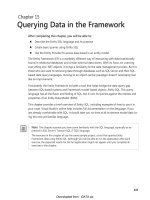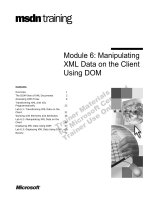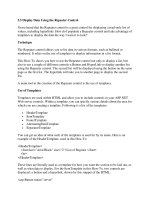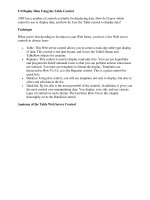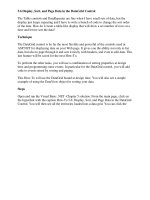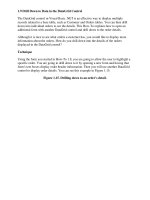Lecture Autodesk inventor Solid modeling data structures
Bạn đang xem bản rút gọn của tài liệu. Xem và tải ngay bản đầy đủ của tài liệu tại đây (141.25 KB, 14 trang )
Solid Modeling Data Structures
Types of Solid Modelers
Constructive solid geometry (CSG)
Boundary representation (B-rep)
Hybrid of CSG and B-rep
Categorization based upon way data is stored in
database
Constructive Solid Modeling (CSG)
Uses Boolean operations to create complex solids
from primitives
Primitives, Boolean operations stored in database
Can make changes to primitives
Tree structure
Range of shapes limited (only primitives and
Booleans)
Since primitives stored (not surface boundaries),
must recalculate model each time it is shaded
Calculation of NC tool paths for machining is a
problem (surface info required)
CSG Tree Structure
Tree structure
represents model
history
Shows which
primitives (leaves)
and operations
(nodes) were used,
and their order
Boundary Representation Modeling
Stores boundaries of solid in database (e.g.,
vertices, edges, faces)
Similar to surface modeling
More difficult to edit once stored
Edge information stored in a systematic way
(CCW from outside)
Shading, hidden line removal can be
displayed at will
B-rep Data Structure
Euler’s Formula: V – E + F = 2
V = # of vertices
E = # of edges
F = # of faces
CSG and B-rep Comparison
Union of two
box primitives
CSG
information
B-rep
information
Hybrid Systems
Most commercial solid modelers employ
a combination of both CSG and B-rep
Store model using both CSG and B-rep
methods
Uses CSG as primary, B-rep as secondary
for display
Large file sizes
Modeling Kernels
Engine used by software to perform basic
functions (Boolean operations, blending, mass
properties, exporting geometry, chamfer/fillet)
Common kernels:
ACIS
Parasolid
Easier to translate between modelers that use
same kernel
3D Modeling Software
Faceted versus Exact Representation
Faceted
Exact
Uses of Solid Models
Accurate representation of 3D objects
Aid to visualization, communication
Can extract 2D drawing information
Used to control CAM methods
Interference identification
Mass property determination
Analysis and simulation (finite element,
kinematics, ergonomics, etc)
Rapid Prototyping
Shortcomings of Solid Models
Difficult to modify a model’s features
Does not capture the design intent
Design Intent is the purpose or function of a
feature in a part (or of a part in an assembly)
Solid Modeling Data Structures
Khallas!
